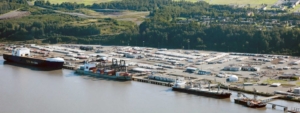American ports, even those that are among the busiest in the world, have faced near-crippling levels of congestion since the outbreak of COVID. Supply chain back-ups have also had a negative impact. The smaller ports especially have scrambled to meet demand, but it is obvious that operational inadequacies at all U.S. ports must be addressed. Now, significant public investment is opening up for port projects of all types.
With funding support from the federal government, port authorities in each coastal region are being upgraded, modernized and electrified. The goal is sustainability because America’s ports are huge contributors to the country’s GDP.
Most of the improvements will apply to deficiencies in cargo handling because container vessels idling outside of ports have consistently increased over the past three years. This issue must be addressed, and U.S. ports must improve their capabilities. Immediate needs and objectives include electrifying cargo handling equipment, upgrading shore power, enhancing electric grid infrastructure and exploring new port-side applications for hydrogen energy.
To assist with all this, the federal government is disbursing billions of dollars to ports through grant programs. The Inflation Reduction Act allocates $3 billion to fund acquisition and installation of zero-emission equipment at ports. Another $1 billion is available to help port authorities electrify their fleets of heavy-duty vehicles. Additionally, $662 million is available through the Department of Transportation’s Maritime Administration. Very soon, 50 funding grants to support projects that improve efficiency and reliability of port operations will be announced.
Examples of upcoming projects now being planned include the following.
The Port of Oakland in California is planning a $48.9 million project to modernize one of its terminals. The port, which is the ninth busiest in the U.S., will use the bulk of its funding for energy and infrastructure improvements. Components of the project will include improvements such as an off-dock container support facility with commercial truck access, perimeter fencing, upgraded storage facilities, refrigerated container storage, LED lighting, drainage enhancements, substation improvements, battery storage and the addition of charging stations. A significant number of the improvements will be scaled to bolster capacity, reliability and resilience of the port’s electrical grid.
Planning officials with the Port of Coos Bay in Oregon will launch a $1.8 billion project to deliver a new rail line, another navigation channel and a container terminal. A public-private partnership will steer the project through its planning phase. Once that is accomplished, construction will launch in 2024. The project will create infrastructure for 12 new trains between the port and nearby city of Eugene and mitigate supply chain congestion that continues to logjam operations.
Another large allocation of funding will be required for the launch of a port project in Anchorage, Ala. This initiative carries a cost projection of approximately $2.2 billion. Port officials and local leaders are working together to oversee the initiative. The updated concept involves construction of two identical terminals to support new cargo-handling cranes that will be roughly three times the size of the port’s current, outdated cranes. State officials have approved $200 million in capital funding and the port will leverage that for matching federal funds to cover the remaining project costs.
State lawmakers in Virginia recently amended the state’s newest budget to allow funding for a new inland port in the southwestern county of Washington. The $65 million project, which also received approval from Washington County officials, is currently in the preliminary planning stage. Features of the initiative will likely include a new rail connection for shipping goods to and from the Port of Virginia to the coastal city of Norfolk.
The Gulf Coast of Texas is planning numerous port-focused contracting opportunities focused on electrification, modernization, resilience and efficiency. Recently, officials representing the Port of Galveston announced plans to issue $100 million in bonds to support the delivery of critically needed improvements. Approval of the bond issue will launch work on projects that include a new cargo complex, upgrades to an existing cruise terminal, and construction of a new, fourth terminal at the port.
Also in Texas, the Port of Corpus Christi has plans for a $1 billion initiative that will include two projects. The first effort will focus on improving existing terminals and the other project will expand terminal storage. Both projects are outlined in the recently released Texas Port Mission Plan for 2024-2025. Additionally, the Port of Corpus Christi Authority is working with the U.S. Army Corps of Engineers on a $682 million ship channel project which will be in development during the same timeframe.
A new port rail connection in New Jersey will carry a large price tag – approximately $100 million. Officials at Port Elizabeth plan to address much-needed upgrades and enhancements. Soon, the port authority plans to allocate funding to improve port operations and finalize the planning of a new port rail connection which will be delivered through a public-private partnership. The new track will connect a regional rail station to the broader national rail network. Construction is slated to begin following selection of a preferred alternative design (tentatively expected in June 2023).
Officials at Southern Florida’s Port Miami, which ranks as the 10th busiest port in the U.S., will announce plans for a landmark capital spending plan. Over the next five years, the port will undergo a series of construction projects with a combined budget of $1.2 billion. The projects will expand cargo operations and position the port to capture a greater amount of the economic activity that is being routed away from congested ports. One objective will be to invest $55 million in new cargo-handling cranes that can operate on the port’s electrical grid. Once this initial work is completed, port officials will begin to work on another $1.6 billion in longer-term capital improvement initiatives.
Companies with offerings and services that can be provided to port authorities will find officials eager to discuss their upcoming initiatives. Federal funding as well as alternative funding will be available, and the only delay now is the wait for planning and design work to be completed.
____________________________________________________________________________________
 Mary Scott Nabers is President/CEO of Strategic Partnerships, Inc. (SPI), a full-service business development firm specializing in procurement consulting, government affairs, research and public-private partnerships (P3s). A former statewide office holder in Texas, Mary founded Strategic Partnerships, Inc after leaving government and later was the co-founder of the Gemini Global Group .
Mary Scott Nabers is President/CEO of Strategic Partnerships, Inc. (SPI), a full-service business development firm specializing in procurement consulting, government affairs, research and public-private partnerships (P3s). A former statewide office holder in Texas, Mary founded Strategic Partnerships, Inc after leaving government and later was the co-founder of the Gemini Global Group .
Mary is a recognized expert in public private partnerships and the author of Collaboration Nation – How Public-Private Ventures Are Revolutionizing the Business of Government and her most recent book Inside the Infrastructure Revolution – A Roadmap for Rebuilding America. She was selected to membership in Icons of Infrastructure and is a regular speaker at industry conferences throughout the country. She writes for a number of national publications and blogs on a weekly basis.
Mary holds an MBA degree from The University of Texas.
For more information – www.spartnerships.com and www.maryscottnabers.com







 RSS Feed
RSS Feed